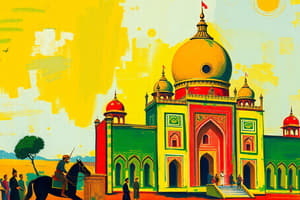Podcast
Questions and Answers
What were cotton and sugarcane known as by the Mughal State?
What were cotton and sugarcane known as by the Mughal State?
- Amlaguzar
- Naqdi
- Jins-i Kamil (correct)
- Kharif and Rabi
What was the main purpose of presenting khilats in the Mughal Empire?
What was the main purpose of presenting khilats in the Mughal Empire?
- To signify the start of a new reign
- To celebrate religious festivals
- To honor loyal subjects and reward their service (correct)
- To conduct diplomatic negotiations
Which crops were considered 'Jins-i Kamil par excellence' by the Mughal State?
Which crops were considered 'Jins-i Kamil par excellence' by the Mughal State?
- Cotton and Sugarcane (correct)
- Mustard and Oilseeds
- Oilseeds and Sugar
- Mustard and Lentils
What did 'Naqdi' refer to in Mughal financial transactions?
What did 'Naqdi' refer to in Mughal financial transactions?
What marked the beginning of the Ilahi era in the Mughal Empire?
What marked the beginning of the Ilahi era in the Mughal Empire?
Which Mughal Emperor introduced the Shamsi coin and based it on the solar calendar?
Which Mughal Emperor introduced the Shamsi coin and based it on the solar calendar?
What was the role of an 'Amlaguzar' in the Mughal administrative system?
What was the role of an 'Amlaguzar' in the Mughal administrative system?
'Jalali' coins were minted during which Mughal Emperor's reign?
'Jalali' coins were minted during which Mughal Emperor's reign?
Where was Bengal famous for its crop production according to the text?
Where was Bengal famous for its crop production according to the text?
What was the primary reason for using the term 'Shinsah' in the context of the Mughal Empire?
What was the primary reason for using the term 'Shinsah' in the context of the Mughal Empire?
What differentiated the troops known as 'Sawar' within the Mughal Empire?
What differentiated the troops known as 'Sawar' within the Mughal Empire?
What do the terms Kharif and Rabi refer to in Mughal agriculture?
What do the terms Kharif and Rabi refer to in Mughal agriculture?
Flashcards are hidden until you start studying
Study Notes
Mughal Agriculture
- Cotton and sugarcane were considered "Jins-i Kamil" or perfect crops by the Mughal state.
- The Mughal state encouraged peasants to cultivate these crops as they generated more revenue.
- Agriculture was organized around two major seasonal cycles: Kharif (autumn) and Rabi (spring).
Mughal Administration
- "Amlaguzar" was an official responsible for revenue and finances in a specific area or district.
- The Amlaguzar oversaw the collection of taxes, land revenue, and other financial matters.
Mughal Currency
- "Shamsi" was a gold coin minted during the Mughal period, named after the solar calendar introduced by Akbar.
- "Jalali" was a silver coin minted during the reign of Shah Jahan, named after the Islamic lunar calendar year.
Mughal Time Measurement
- The "Ilahi" was a unit of measurement for time introduced by Emperor Akbar as part of his administrative and religious reforms.
- The Ilahi calendar was a hybrid of the Islamic lunar calendar and the Hindu solar calendar.
Mughal Titles
- "Shinsah" and "Shahenshah" were titles used by Mughal emperors, meaning "King of Kings" or "Emperor".
Mughal Military
- "Sawar" referred to troops raised by the Emperor but not paid directly by the state, placed under the charge of Mansabdars.
Studying That Suits You
Use AI to generate personalized quizzes and flashcards to suit your learning preferences.




